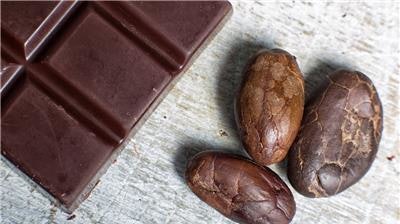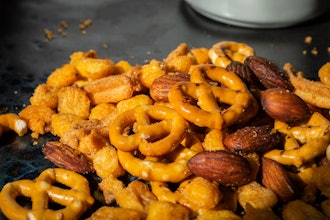
An estimated $2.2 billion is spent on Valentine’s Day candy every year — with the bulk of that money going to chocolate.
The industrial chocolate market size is expected to grow by USD 2.85 billion from 2023 to 2028, according to Technavio. Growing customer awareness of the health benefits of dark chocolate is one major reason behind the market’s continuing success. A myriad of consumer goods contain some form of chocolate or cocoa, and global demand for the product has rarely slowed.
While the target audience for industrial chocolate products continues to be commercial food companies, private customers can still take advantage of the industry’s ability to customize their offerings. For chocolate-related products, there are a lot of customization options. This can include anything from flavor and aroma, composition, viscosity, melting behavior, performance, production cost, and product certifications such as halal and kosher to product claims, which can involve sugar, oils, fat, and dairy.
Anna Chesley from The 1800s Housewife shares her industrial chocolate experience. “I have a child with multiple food sensitivities, and high-quality chocolate that’s both free of allergens and Fair Trade certified can be hard to come by, not to mention expensive! I have found that ordering our favorite dark chocolate 50 pounds at a time through a local food co-op saves me a huge amount of money over the course of a year and makes it possible to access a higher quality chocolate than is available in our rural grocery stores.”
From Bean to Bar: How Industrial Chocolate Is Produced
Raw Cocoa Beans Get Roasted
Much like coffee beans, raw cocoa beans have none of the flavors associated with the finished product. The actual chocolate flavor profile begins with the first processing step: dry heat roasting. Commercial roasters add superheated air to the beans as they circulate inside the unit. This creates the color and aroma associated with cocoa beans and eliminates any contaminants from the growing field, including mold, bacteria, soil, and fungi.
Dry roasting also makes the bean’s outer shell brittle and easier to remove. The ultimate goal at this point is to remove the outer shell, break down the inner bean, and remove the tiny nibs for processing. Surprisingly, chocolate and water do not mix, so the roasting process also reduces the moisture content to around 1%.
Winnowing Out Unwanted Shells
After the roasted cocoa beans cool, specialized machines mechanically crack open the outer shells and filter out the edible nibs for collection. Because the dried outer shells are lighter than the nibs, forced air is used to separate the shells from the nibs during the winnowing process. The goal is to remove as many shells and husks as possible to avoid affecting the flavor of the nibs.
Time for Grinding
The freshly roasted and separated cocoa nibs contain 50-55% cocoa butter, a vital ingredient in the industrial chocolate-making process, but it needs to be pressed out mechanically. Rotating metal grinders convert the nibs into a liquid called chocolate liquor. Chocolate liquor serves several purposes, but it is still a blend of cocoa butter and nib solids.
Depending on the quality requirements of the finished product, chocolate liquor can be put through three or more grinding sessions, eventually reducing the size of the solid particles to a fine powder.
Separating the Cocoa Butter From the Press Cake
Chocolate liquor still contains cocoa butter, but it must be separated mechanically under significant pressure. Hydraulic presses or rollers apply enough pressure on the chocolate liquor to remove the cocoa butter as a yellow liquid. This essential ingredient is collected and stored for future use. The remaining solid is called a press cake; the factory will later process it into cocoa powder.
Blending the Cocoa Butter Back In
While blending an extracted ingredient back into the mix may sound counterintuitive, this is precisely what happens next in the chocolate-making process. Different chocolate-based products require different ratios of liquid cocoa butter and solid press cake. Higher amounts of cocoa butter determine the overall texture and mouthfeel of the finished product, and the ingredients must be blended back together under tightly controlled conditions.
Conching: The Most Critical Stage
At this stage, the cocoa butter/press cake blend contains no additional flavorings, additives, or sweeteners. The process called conching determines the quality of the finished product. A machine equipped with a large paddle moves slowly through the base chocolate, incorporating air and improving the thoroughness of the previous blending stage. The size of the press cake is further reduced as well.
This is also where additional ingredients are added to the blended chocolate. These ingredients include sugar, milk powder or liquid milk, flavorings, and solid mix-ins. The conching stage relies heavily on the processing speed and the chocolate base’s temperature.
Tempering the Final Product
Because of its crystalline structure, chocolate must be cooled down at a controlled rate. The tempering stage uses special machines to maintain the chocolate’s integrity as it cools to a workable temperature. Improper tempering can cause ingredients to separate at the point of solidification. Chocolate can also seize up and form a grainy texture if not properly tempered.
The tempering stage is where many chocolate bars gain their shiny appearance and crisp texture. Tempering also prevents excessive melting.
Molding the Product
Industrial chocolate is sold to commercial vendors and private customers in various forms, and molding machines create those forms. The tempered liquid chocolate is poured into molds shaped like bars, blocks, shells, customized designs, and other options. This is where fillings such as nougat or jelly are inserted into a shell’s cavity, or additional ingredients, typically nuts, dried fruits, or decorative coatings, can safely be added. This step can be fully automated, semi-automated, or performed manually in smaller operations.
Wrapping and Packaging
The final stage in the industrial chocolate-making process creates the familiar candies, chips, toppings, and additives many consumers recognize on sight. The finished chocolate product is loaded into a machine, and the appropriate wrapper gives it a distinct identification. Wrapping also protects the product from contaminants and the damaging effects of shipping and storage.
Industrial chocolate machines use various wrapping papers, commonly wax-coated, foil-covered, or plastic-based, to create a customized finished product for retailers. Some wrappers form protective sleeves, while others are sealed with a twist or folded with a band.
Forms of Industrial Chocolate
Unlike the familiar chocolate candy bars or powdered cocoa in retail stores, industrial chocolate is often sold to commercial food producers and bakeries in bulk sizes. The product can take on a range of forms, depending on the client’s specific needs. An enrobing machine, for example, requires a flowing curtain of liquid chocolate, while a chocolate paste or powder is a better fit for baking applications. Some common forms of industrial chocolate include:
- Blocks/Tablets
- Sticks
- Kibbles
- Coins
- Chips/Drops
- Chocolate Paste
- Powder Mix
- Chunks
Chocolate coins are often sold in craft stores in various flavors and forms, such as white, milk, and dark chocolate. The tempered coins melt easily in a microwave or double boiler, ready to be poured into candy molds. This is one of the most common introductions to the fascinating world of industrial chocolate.
Advice From a Chocolate Expert
Dédé Wilson, author of several chocolate-related cookbooks, offers her take on using industrial chocolate at home. “Whether you want to work with chocolate on a very large scale, or are looking to create chocolate for friends and family, or perhaps a school project or bake sale (which I am defining as a smaller scale), there are several factors to take into consideration. A budget has to be considered, as well as any equipment that may or may not be involved.”
Wilson has some final advice for amateur chocolatiers and sweet lovers out there, saying, “As for purchasing chocolate for any of your projects, you certainly can buy in bulk, which is usually more economical. Contact bakery supply companies in your area and see what they offer, or look online. Very often, chocolate comes in large slabs that are about 11 pounds, or you can purchase wafers or pallets that are small pieces and meant for melting.”
This article was produced by Media Decision and syndicated by Wealth of Geeks.






















